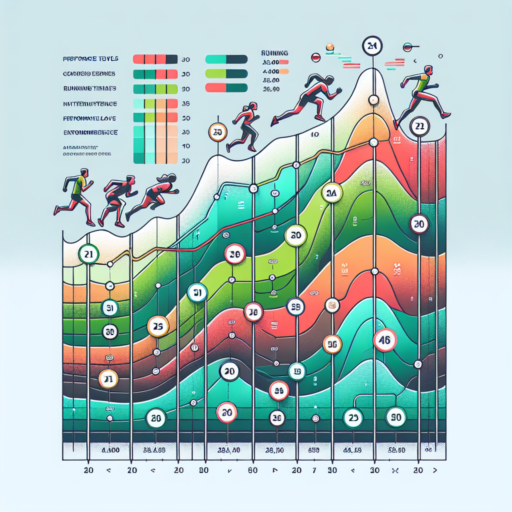What is running metrics?
Running metrics are crucial data points that track and analyze a runner’s performance over time. These metrics not only monitor basic elements such as speed, distance, and time but also delve into more complex measurements like cadence, stride length, and vertical oscillation. Collecting and understanding this data can lead to significant improvements in an athlete’s efficiency, form, and overall running economy.
At the heart of running metrics is the aim to enhance a runner’s training outcomes and reduce the risk of injury. For instance, cadence – the number of steps a runner takes per minute – can provide insights into running form and efficiency. A higher cadence is often associated with a more efficient running form, which could lead to improved performance and decreased injury risk.
Stride length and vertical oscillation are other key metrics that offer a deep dive into a runner’s technique. While stride length measures the distance covered between steps, vertical oscillation gauges the movement in the runner’s center of mass. Together, these metrics can highlight areas for improvement in a runner’s form, potentially leading to better performance and enhanced injury prevention.
What are the key performance indicators for running?
Understanding the key performance indicators (KPIs) for running is essential for runners of all levels, from beginners to elite athletes, aiming to improve their performance, set personal records, and achieve their running goals. These indicators are crucial metrics that help in tracking progress, setting realistic goals, and identifying areas of improvement. Let’s delve into some of the primary KPIs that are cornerstone to a runner’s performance.
Distance Covered and Pace
One of the most straightforward yet pivotal metrics for any runner is the distance they cover in a run and the pace at which they run. Distance gives a clear picture of endurance levels and progression over time, whereas pace, often calculated in minutes per mile or kilometer, helps in understanding speed capabilities and setting pace-related goals. Monitoring changes and patterns in these two metrics can guide in tailoring training regimens for better results.
Heart Rate
Another vital KPI for runners is their heart rate during both rest and activity. It is an excellent indicator of cardiovascular health and running efficiency. A lower heart rate at a given pace suggests improved efficiency and endurance. Utilizing heart rate zones to guide training intensity can significantly enhance a runner’s performance durability and speed recovery.
Split Times
Split times, or the time it takes to complete specific segments of a run, offer valuable insights into a runner’s consistency and pacing strategy. It allows runners to analyze their performance across different parts of a run, identifying strengths and weaknesses in pacing across varying terrains and distances. By adjusting strategies based on split time analysis, runners can improve overall race strategies and performance outcomes.
How to measure running performance?
Measuring your running performance is essential for tracking progress, setting goals, and identifying areas for improvement. There are several metrics and tools you can use to get a comprehensive view of your running efficiency and endurance.
Key Metrics for Evaluating Running Performance
- Speed and Pace: One of the most direct measures of running performance is how fast you can run a certain distance. Tracking your average speed or pace over time can help you gauge improvements in your running ability.
- Distance: The total distance covered during a run or over a period of training sessions can indicate enhancements in endurance and stamina.
- Heart Rate: Monitoring your heart rate during runs provides insight into your cardiovascular system’s efficiency and recovery rate. Lower heart rates at higher speeds typically indicate better running performance.
To accurately measure these aspects of your running performance, utilizing technology such as GPS watches, running apps, and heart rate monitors can be incredibly beneficial. These tools offer detailed insights and allow for precise tracking over time. Remember, consistency in measuring your performance is key to obtaining reliable data and effectively monitoring your progress.
What do advanced running metrics mean?
Understanding advanced running metrics can transform a casual jog into an in-depth analysis of one’s performance, health, and progress. Beyond the simple measure of distance and time, these metrics offer insights into the runner’s efficiency, endurance, and risk of injury. By delving into what these sophisticated figures represent, runners can make informed decisions about their training routines, footwear, and recovery needs.
Key Advanced Running Metrics
- Cadence: Often measured in steps per minute, cadence sheds light on the runner’s stride rate. A higher cadence has been associated with increased efficiency and reduced injury risk.
- Stride Length: This metric indicates the distance covered in each step. Understanding the balance between stride length and cadence is crucial for optimizing running form.
- Vertical Oscillation: The measurement of how much a runner ‘bounces’ in each step. Lower values in vertical oscillation are typically a sign of better running economy.
By analyzing these metrics, runners gain insight into areas that need improvement, such as cadence or stride length, which can lead to more effective training strategies. For instance, focusing on increasing cadence may help reduce the impact on joints and decrease the risk of injuries. Similarly, understanding vertical oscillation can help runners work on a smoother, more efficient running style. These metrics, therefore, are not just numbers but are actionable data points that can significantly enhance a runner’s performance and health.










